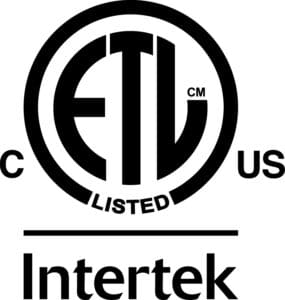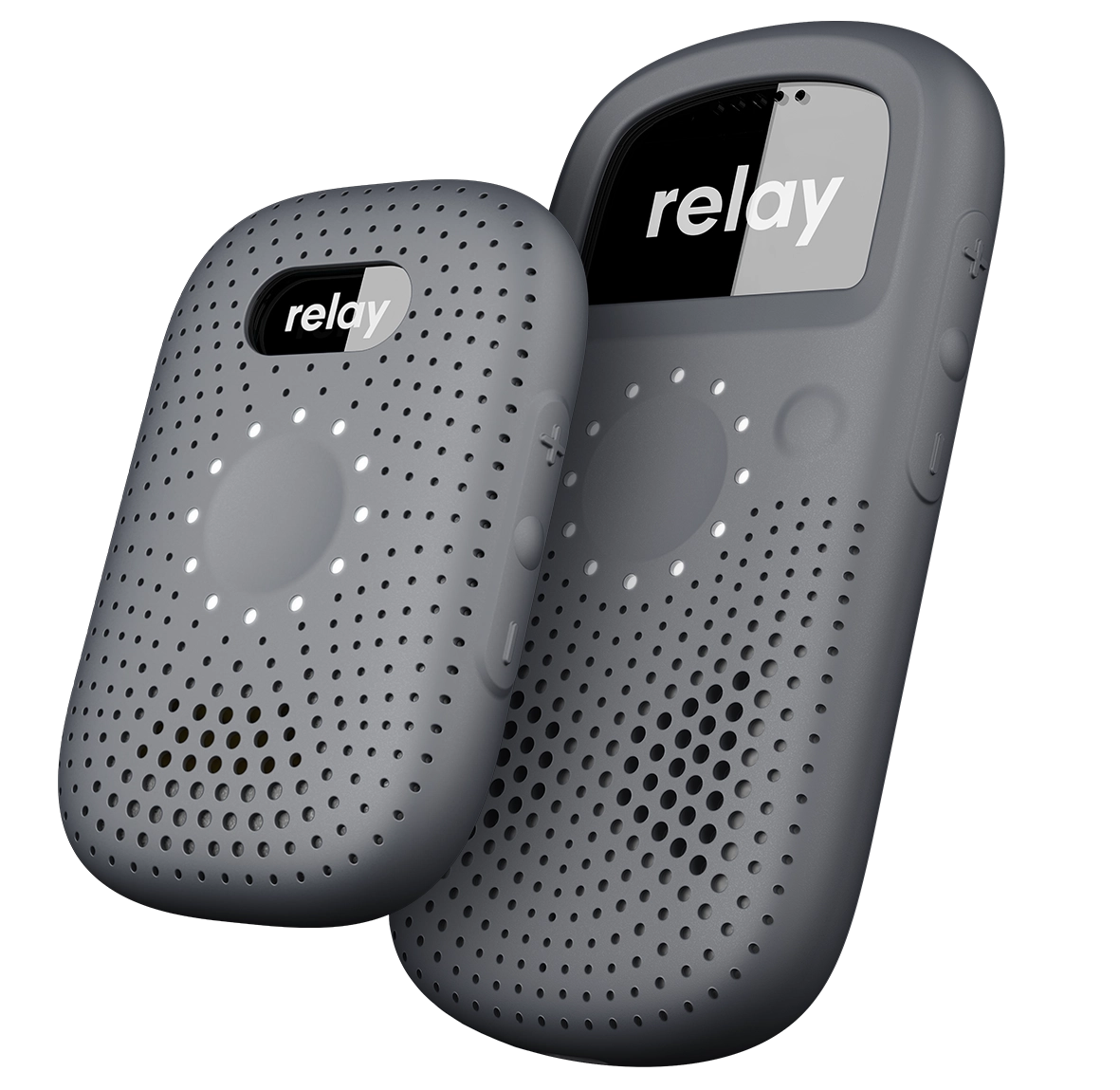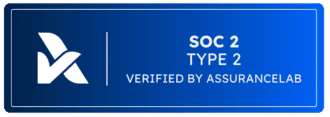Safety and Regulatory Information
RelayX model RY2268 Safety and Regulatory Information
Please review the product information, health and safety information and instructions at relaypro.com before using your device. You can also find a link to the limited warranty, regulatory information and additional support resources from there.
Electronic Shock and Heat:
Do not expose RelayX or its power charger to water or extreme conditions. Handle with care to avoid electric shock when using the power charger. Only use the provided power charger to charge the RelayX unit. If your RelayX unit power charger or unit is hot to the touch, please unplug the RelayX and the power charger and let it cool.
Pacemakers and Other Implanted Devices:
RelayX contains magnets and components that emit an electromagnetic field and could interfere with pacemakers or other electronic medical devices. Before using your RelayX, consult with your doctor or medical device manufacturer about the required safe distance between RelayX and your medical device.
FCC Regulations:
This device complies with part 15 of the FCC Rules. Operation is subject to the following two conditions: (1) This device may not cause harmful interference, and (2) this device must accept any interference received, including interference that may cause undesired operation.
This device has been tested and found to comply with the limits for a Class B digital device, pursuant to Part 15 of the FCC Rules. These limits are designed to provide reasonable protection against harmful interference in a residential installation. This equipment generates, uses and can radiate radio frequency energy and, if not installed and used in accordance with the instructions, may cause harmful interference to radio communications. However, there is no guarantee that interference will not occur in a particular installation. If this equipment does cause harmful interference to radio or television reception, which can be determined by turning the equipment off and on, the user is encouraged to try to correct the interference by one or more of the following measures:
- Reorient or relocate the receiving antenna.
- Increase the separation between the equipment and receiver.
- Connect the equipment into an outlet on a circuit different from that to which the receiver is connected.
- Consult the dealer or an experienced radio/TV technician for help.
Caution: Changes or modifications not expressly approved by the party responsible for compliance could void the user‘s authority to operate the equipment.
FCC RF Exposure Information (SAR)
This device is designed and manufactured not to exceed the emission limits for exposure to radio frequency (RF) energy set by the Federal Communications Commission of the United States.
During SAR testing, this device is set to transmit at its highest certified power level in all tested frequency bands, and placed in positions that simulate RF exposure in usage near the body with the separation of 5 mm. To reduce exposure to RF energy, use the hands-free option with the built-in speakerphone, or an optional set of headphones, or other similar accessories. Although the SAR is determined at the highest certified power level, the actual SAR level of the while operating can be well below the maximum value. This is because the device is designed to operate at multiple power levels so as to use only the power required to reach the network. In general, the closer you are to a wireless base station antenna, the lower the power output.
The FCC has granted an Equipment Authorization for this model device with all reported SAR levels evaluated as in compliance with the FCC RF exposure guidelines. SAR information on this model device is on file with the FCC and can be found under the Display Grant section of www.fcc.gov/oet/ea/fccid after searching on FCC ID: 2AMBHRY2268.
The exposure standard for wireless employs a unit of measurement known as the Specific Absorption Rate, or SAR. The SAR limit set by the FCC is 1.6W/kg averaged over one gram of tissue. The highest SAR value reported under this standard during product certification is Head 1.17W/Kg and Body 1.16W/Kg.
When the use of Ultra Wideband is prohibited in your region, such as while in an aircraft, Ultra Wideband can be turned off by powering your Relay device off.
In the US, UWB devices may not be employed for the operation of toys. Operation onboard an aircraft, a ship or a satellite is prohibited.
Operation of transmitters in the 5.925-7.125 GHz band is prohibited for control of or communications with
unmanned aircraft systems.
IC Notice
This device complies with Industry Canada license-exempt RSS standard(s). Operation is subject to the following two conditions:
(1) this device may not cause interference, and
(2) this device must accept any interference, including interference that may cause undesired operation of the device.
The device is restricted to indoor use only when operating in the 5150 to 5250 MHz frequency range.
Devices shall not be used for control of or communications with unmanned aircraft systems.
Le présent appareil est conforme aux CNR d’Industrie Canada applicables aux appareils radio exempts de licence. L’exploitation est autorisée aux deux conditions suivantes:
(1) l’appareil ne doit pas produire de brouillage, et
(2) l’utilisateur de l’appareil doit accepter tout brouillage radioélectrique subi, même si le brouillage est susceptible d’en
L’appareil est réservé à l’intérieur seulement lorsqu’il fonctionne dans la gamme de fréquences 5150 à 5250 MHz.
Les dispositifs ne doivent pas être utilisés pour commander des systèmes d’aéronef sans pilote ni pour communiquer avec de tels systèmes.
CAN ICES-3 (B)/NMB-3(B)
This Class B digital apparatus complies with Canadian ICES-003.
Cet appareil numérique de la classe B est conforme à la norme NMB-003 du Canada.
IC: 25353-RY2268
IC Radiation Exposure Statement
This EUT is compliance with SAR for general population/uncontrolled exposure limits in IC RSS-102 and had been tested in accordance with the measurement methods and procedures specified in IEEE 1528 and IEC 62209. This equipment should be installed and operated with minimum distance 1.0 cm between the radiator and your body. This device and its antenna(s) must not be co-located or operating in conjunction with any other antenna or transmitter.
Cet appareil est conforme aux limites d’exposition DAS incontrôlée pour la population générale de la norme CNR-102 d’Industrie Canada et a été testé en conformité avec les méthodes de mesure et procédures spécifiées dans IEEE 1528 et IEC 62209. Cet appareil doit être installé et utilisé avec une distance minimale de 1.0 cm entre l’émetteur et votre corps. Cet appareil et sa ou ses antennes ne doivent pas être co-localisés ou fonctionner en conjonction avec tout autre antenne ou transmetteur.
RelayX model RY2268 Hazardous Location Certification Information
RelayX is certified for use in Hazardous Locations as a Non-Incendive device under the North American classification markings: Class I Division 2, Groups A, B, C & D; Class II Division 2, Groups F & G; Class III Division 1 & Division 2.
RelayX is listed under Intertek Control # 5031865.
Conforms to UL STD 121201 & 62368-1
Certified to CSA STD C22.2#213 & 62368-1

5031865
Warning:
Explosion Hazard: Do not charge or connect any wire to the USB-C port while the hazardous area is present.
Do not open or disassemble the device.
Risque d’explosion: Ne chargez pas et ne connectez aucun fil au port USB-C lorsque la zone dangereuse est présente.
N’ouvrez pas l’équipement
Proposition 65 Information for California Residents
For more information, go to www.P65Warnings.ca.gov
Relay+ model RW2266 Safety and Regulatory Information
Please review the product information, health and safety information and instructions at relaypro.com before using your device. You can also find a link to the limited warranty, regulatory information and additional support resources from there.
Electronic Shock and Heat:
Do not expose Relay+ or its power charger to water or extreme conditions. Handle with care to avoid electric shock when using the power charger. Only use the provided power charger to charge the Relay+ unit. If your Relay+ unit power charger or unit is hot to the touch, please unplug the Relay+ and the power charger and let it cool.
Pacemakers and Other Implanted Devices:
Relay+ contains magnets and components that emit an electromagnetic field and could interfere with pacemakers or other electronic medical devices. Before using your Relay+, consult with your doctor or medical device manufacturer about the required safe distance between Relay+ and your medical device.
FCC Regulations:
This device complies with part 15 of the FCC Rules. Operation is subject to the following two conditions: (1) This device may not cause harmful interference, and (2) this device must accept any interference received, including interference that may cause undesired operation.
This device has been tested and found to comply with the limits for a Class B digital device, pursuant to Part 15 of the FCC Rules. These limits are designed to provide reasonable protection against harmful interference in a residential installation. This equipment generates, uses and can radiate radio frequency energy and, if not installed and used in accordance with the instructions, may cause harmful interference to radio communications. However, there is no guarantee that interference will not occur in a particular installation. If this equipment does cause harmful interference to radio or television reception, which can be determined by turning the equipment off and on, the user is encouraged to try to correct the interference by one or more of the following measures:
- Reorient or relocate the receiving antenna.
- Increase the separation between the equipment and receiver.
- Connect the equipment into an outlet on a circuit different from that to which the receiver is connected.
- Consult the dealer or an experienced radio/TV technician for help.
Caution: Changes or modifications not expressly approved by the party responsible for compliance could void the user‘s authority to operate the equipment.
FCC RF Exposure Information (SAR)
This device is designed and manufactured not to exceed the emission limits for exposure to radio frequency (RF) energy set by the Federal Communications Commission of the United States.
During SAR testing, this device is set to transmit at its highest certified power level in all tested frequency bands, and placed in positions that simulate RF exposure in usage near the body with the separation of 5 mm. To reduce exposure to RF energy, use the hands-free option with the built-in speakerphone, or an optional set of headphones, or other similar accessories. Although the SAR is determined at the highest certified power level, the actual SAR level of the while operating can be well below the maximum value. This is because the device is designed to operate at multiple power levels so as to use only the power required to reach the network. In general, the closer you are to a wireless base station antenna, the lower the power output.
The FCC has granted an Equipment Authorization for this model device with all reported SAR levels evaluated as in compliance with the FCC RF exposure guidelines. SAR information on this model device is on file with the FCC and can be found under the Display Grant section of www.fcc.gov/oet/ea/fccid after searching on FCC ID: 2AMBHRW2266.
The exposure standard for wireless employs a unit of measurement known as the Specific Absorption Rate, or SAR. The SAR limit set by the FCC is 1.6W/kg averaged over one gram of tissue. The highest SAR value reported under this standard during product certification is Head – 1.16 W/Kg and Body – 1.19W/Kg.
IC Notice
This device complies with Industry Canada license-exempt RSS standard(s). Operation is subject to the following two conditions:
(1) this device may not cause interference, and
(2) this device must accept any interference, including interference that may cause undesired operation of the device.
Le présent appareil est conforme aux CNR d’Industrie Canada applicables aux appareils radio exempts de licence. L’exploitation est autorisée aux deux conditions suivantes:
(1) l’appareil ne doit pas produire de brouillage, et
(2) l’utilisateur de l’appareil doit accepter tout brouillage radioélectrique subi, même si le brouillage est susceptible d’en
CAN ICES-3 (B)/NMB-3(B)
This Class B digital apparatus complies with Canadian ICES-003.
Cet appareil numérique de la classe B est conforme à la norme NMB-003 du Canada.
IC: 25353-RW2266
IC Radiation Exposure Statement
This EUT is compliance with SAR for general population/uncontrolled exposure limits in IC RSS-102 and had been tested in accordance with the measurement methods and procedures specified in IEEE 1528 and IEC 62209. This equipment should be installed and operated with minimum distance 1.0 cm between the radiator and your body. This device and its antenna(s) must not be co-located or operating in conjunction with any other antenna or transmitter.
Cet appareil est conforme aux limites d’exposition DAS incontrôlée pour la population générale de la norme CNR-102 d’Industrie Canada et a été testé en conformité avec les méthodes de mesure et procédures spécifiées dans IEEE 1528 et IEC 62209. Cet appareil doit être installé et utilisé avec une distance minimale de 1.0 cm entre l’émetteur et votre corps. Cet appareil et sa ou ses antennes ne doivent pas être co-localisés ou fonctionner en conjonction avec tout autre antenne ou transmetteur.
Proposition 65 Information for California Residents
For more information, go to www.P65Warnings.ca.gov
Relay model RW2265 Safety and Regulatory Information
Please review the product information, health and safety information and instructions at relaypro.com before using your device. You can also find a link to the limited warranty, regulatory information and additional support resources from there.
Electronic Shock and Heat:
Do not expose Relay or its power charger to water or extreme conditions. Handle with care to avoid electric shock when using the power charger. Only use the provided power charger to charge the Relay unit. If your Relay unit power charger or unit is hot to the touch, please unplug the Relay and the power charger and let it cool.
Pacemakers and Other Implanted Devices:
Relay contains magnets and components that emit an electromagnetic field and could interfere with pacemakers or other electronic medical devices. Before using your Relay, consult with your doctor or medical device manufacturer about the required safe distance between Relay and your medical device.
FCC Regulations:
This device complies with part 15 of the FCC Rules. Operation is subject to the following two conditions: (1) This device may not cause harmful interference, and (2) this device must accept any interference received, including interference that may cause undesired operation.
This device has been tested and found to comply with the limits for a Class B digital device, pursuant to Part 15 of the FCC Rules. These limits are designed to provide reasonable protection against harmful interference in a residential installation. This equipment generates, uses and can radiate radio frequency energy and, if not installed and used in accordance with the instructions, may cause harmful interference to radio communications. However, there is no guarantee that interference will not occur in a particular installation. If this equipment does cause harmful interference to radio or television reception, which can be determined by turning the equipment off and on, the user is encouraged to try to correct the interference by one or more of the following measures:
- Reorient or relocate the receiving antenna.
- Increase the separation between the equipment and receiver.
- Connect the equipment into an outlet on a circuit different from that to which the receiver is connected.
- Consult the dealer or an experienced radio/TV technician for help.
Caution: Changes or modifications not expressly approved by the party responsible for compliance could void the user‘s authority to operate the equipment.
FCC RF Exposure Information (SAR)
This device is designed and manufactured not to exceed the emission limits for exposure to radio frequency (RF) energy set by the Federal Communications Commission of the United States.
During SAR testing, this device is set to transmit at its highest certified power level in all tested frequency bands, and placed in positions that simulate RF exposure in usage near the body with the separation of 10 mm. To reduce exposure to RF energy, use the hands-free option with the built-in speakerphone, or an optional set of headphones, or other similar accessories. Although the SAR is determined at the highest certified power level, the actual SAR level of the while operating can be well below the maximum value. This is because the device is designed to operate at multiple power levels so as to use only the power required to reach the network. In general, the closer you are to a wireless base station antenna, the lower the power output.
The FCC has granted an Equipment Authorization for this model device with all reported SAR levels evaluated as in compliance with the FCC RF exposure guidelines. SAR information on this model device is on file with the FCC and can be found under the Display Grant section of www.fcc.gov/oet/ea/fccid after searching on FCC ID: 2AMBHRW2265.
The exposure standard for wireless employs a unit of measurement known as the Specific Absorption Rate, or SAR. The SAR limit set by the FCC is 1.6W/kg averaged over one gram of tissue. The highest SAR value reported under this standard during product certification is Head – 1.17 W/Kg and Body – 1.20 W/Kg.
Proposition 65 Information for California Residents
For more information, go to www.P65Warnings.ca.gov

